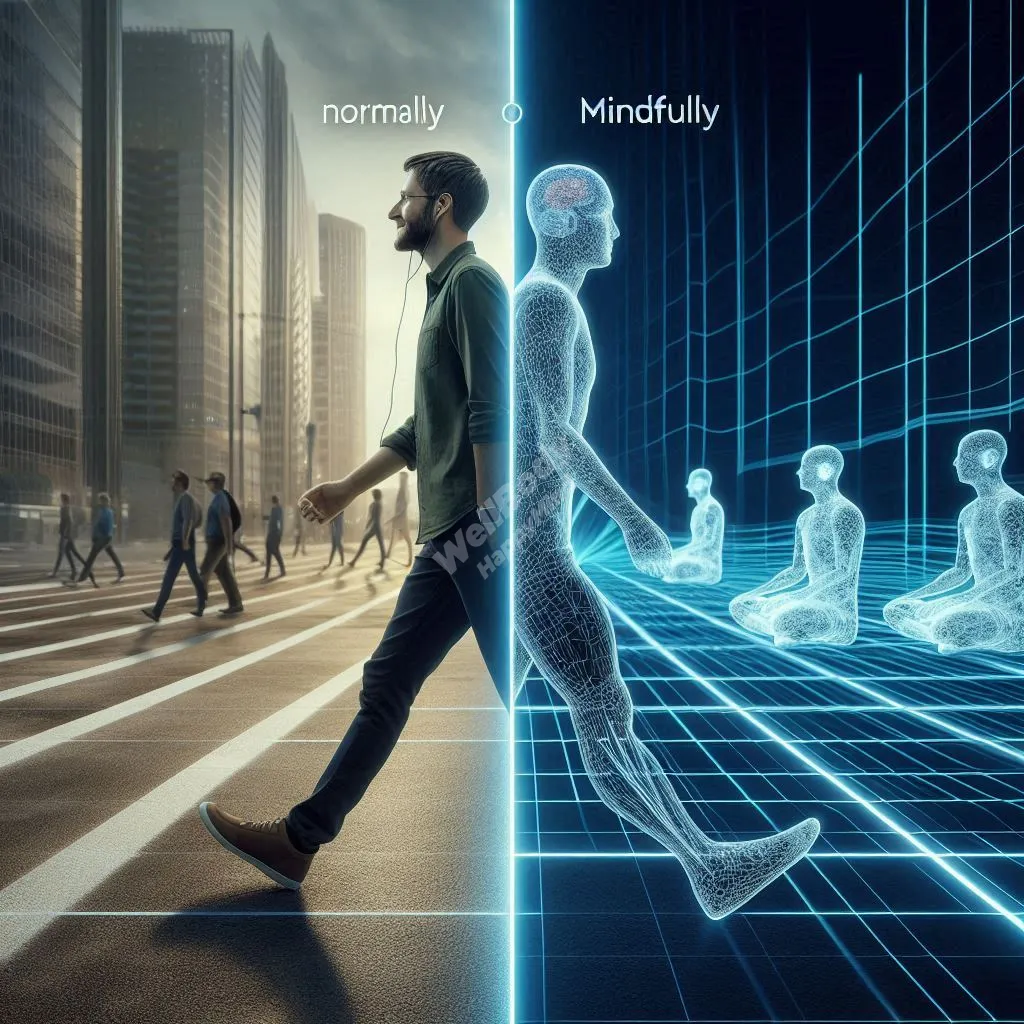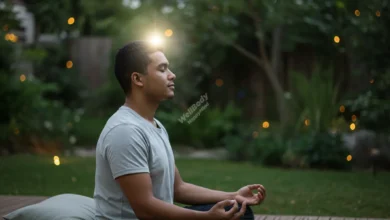12 Ways to Use Mindful Walking to Inspire Creativity

I. Introduction
Have you ever noticed how your best ideas seem to pop up when you’re taking a casual stroll? There’s a reason for that! Welcome to the world of mindful walking, a simple yet powerful tool that can unlock your creative potential.
Mindful walking is like giving your brain a gentle massage while your feet do the work. It’s a way of moving that helps you notice the world around you and the thoughts inside your head. When you combine this awareness with the physical act of walking, something magical happens – your creativity starts to flow!
In this post, we’ll explore 12 exciting ways to use mindful walking to boost your creativity. Whether you’re a writer facing a blank page, an artist in search of inspiration, or anyone looking to think outside the box, these techniques will help you tap into your inner creative genius. Ready to take your first step towards a more imaginative you?
II. Understanding Mindful Walking

Mindful walking is more than just a stroll in the park. It’s a form of moving meditation that blends physical activity with mental focus. Here’s what you need to know:
A. Definition and core principles:
- Mindful walking means walking with full awareness of each step and breath.
- It involves paying attention to your body, surroundings, and thoughts without judgment.
- The goal is to stay present in the moment, not to reach a destination.
B. Benefits for mental health and creativity:
- Reduces stress and anxiety
- Improves mood and emotional balance
- Enhances focus and concentration
- Boosts creative thinking and problem-solving skills
- Increases self-awareness and intuition
C. How it differs from regular walking:
- Regular walking is often done on autopilot, while mindful walking involves intentional awareness.
- Mindful walking is usually slower and more deliberate.
- The focus is on the journey, not the destination.
- It encourages engagement with your surroundings rather than distraction.
By understanding these basics, you’re laying the foundation for using mindful walking as a powerful tool for inspiring creativity.
III. Setting the Stage for Creative Mindful Walking
To get the most out of your mindful walking experience and boost your creativity, it’s important to set the right conditions. Here’s how to prepare:
A. Choosing the right environment:
- Look for natural settings like parks, forests, or beaches.
- Quiet neighborhoods or urban areas with interesting architecture can also work.
- The key is to find a place where you feel safe and can walk without too many interruptions.
B. Preparing your mind and body:
- Take a few deep breaths to center yourself.
- Do some light stretching to loosen up your muscles.
- Put away your phone or set it to “do not disturb” mode.
- Wear comfortable clothing and shoes suitable for walking.
C. Setting intentions for your walk:
- Decide on a specific creative goal for your walk. For example:
- Coming up with new ideas for a project
- Solving a problem you’ve been stuck on
- Finding inspiration for a piece of art or writing
- Choose one or two mindful walking techniques (which we’ll explore next) to focus on during your walk.
- Remind yourself to stay open and curious about your surroundings and thoughts.
By setting the stage properly, you’re creating the perfect conditions for creativity to flourish during your mindful walk.
IV. 12 Ways to Use Mindful Walking for Creativity
1. Sensory Awareness Walk
- Focus on each sense individually:
- Sight: Notice colors, shapes, and movements around you
- Sound: Listen for both loud and subtle noises
- Touch: Feel the ground beneath your feet, the air on your skin
- Smell: Identify different scents in the environment
- Taste: Notice any tastes in your mouth (if applicable)
- This heightens your observation skills, making you more attuned to details that can spark creative ideas.
2. Nature-Inspired Brainstorming
- Collect small natural objects during your walk (leaves, pebbles, etc.)
- Use these as creative prompts. Ideas include:
- Writing a story featuring the object
- Sketching the object from different angles
- Using the object’s texture or color as inspiration for a design
- Imagining the object’s “life story”
3. Walking Meditation with a Creative Question
- Steps to formulate a creative question:
- Identify your creative challenge
- Frame it as an open-ended question (e.g., “How can I make my characters more relatable?”)
- Keep the question simple and focused
- Technique:
- Start walking at a comfortable pace
- Repeat your question silently with each step
- Let your mind wander, but gently return to the question when you notice your thoughts drifting
4. Rhythm and Movement Inspiration
- Focus on the natural rhythms of your body while walking:
- Your footsteps
- Your breathing
- The swinging of your arms
- Translate these rhythms into creative ideas. For example:
- A new dance move
- A musical beat or melody
- A poetic meter for writing
- A pattern for visual art
5. Color Walk
- Choose a color before you start walking
- During your walk, focus on finding as many shades and variations of that color as possible
- Ways to apply this to creative projects:
- Create a color palette for a design project
- Write a poem or story using color-related words
- Develop a mood board for an art piece
- Inspire a new color scheme for your living space
6. Mindful Photography Walk
- Tips for taking mindful photographs:
- Walk slowly and observe your surroundings carefully
- Look for interesting patterns, textures, or light
- Focus on details often overlooked
- Take photos without judgment or overthinking
- This practice enhances visual creativity by training your eye to notice unique perspectives
7. Walking Storytelling
- Technique:
- As you walk, create a story inspired by your surroundings
- Each new thing you notice becomes part of the narrative
- Let the story evolve naturally as you move
- Benefits:
- Improves narrative skills
- Enhances ability to connect seemingly unrelated ideas
- Boosts imaginative thinking
8. Constraint Walks
- Set a creative constraint before walking. Examples:
- Use only words starting with a specific letter
- Focus on geometric shapes in your environment
- Imagine your surroundings in black and white
- How limitations spark creativity:
- Forces you to think outside the box
- Challenges you to find novel solutions
- Encourages deeper observation and engagement with your environment
9. Mindful Sketching Breaks
- Instructions:
- Bring a small sketchbook and pencil on your walk
- Stop periodically to make quick sketches (1-2 minutes each)
- Focus on capturing the essence rather than details
- Don’t judge your drawings; this is about observation, not perfection
- Benefits:
- Enhances visual thinking skills
- Improves ability to quickly capture ideas
- Trains your eye to notice interesting details
10. Wordplay Walk
Techniques:
* Create acronyms from signs or license plates you see
* Play word association games based on objects you encounter
* Invent new words to describe your surroundings
– This enhances **verbal creativity** and can be especially helpful for writers or marketers
11. Problem-Solving Walk
– Steps:
1. Before walking, clearly define a problem you’re facing
2. As you walk, imagine the problem dissolving with each step
3. Be open to new perspectives and solutions that come to mind
4. If an idea strikes, stop to jot it down briefly, then continue walking
– Mindfulness techniques:
* Focus on your breathing to clear your mind
* Visualize the problem as a physical object you can examine from different angles
12. Gratitude and Appreciation Walk
– Explain:
* As you walk, focus on things you’re grateful for in your environment
* Appreciate the beauty in both natural and human-made objects
* Consider how these elements could inspire your creative work
– How this opens new perspectives:
* Shifts your mindset to a more positive, receptive state
* Helps you find beauty and inspiration in unexpected places
* Can lead to more optimistic and uplifting creative outputs
These 12 techniques offer a variety of ways to use mindful walking to inspire creativity. Each method taps into different aspects of the creative process, from observation and problem-solving to wordplay and visual thinking.
V. Integrating Mindful Walking into Your Creative Routine
A. Tips for making it a regular practice:
- Start small: Begin with just 5-10 minutes of mindful walking daily
- Schedule it: Set a specific time for your walks to build consistency
- Pair it: Combine mindful walking with an existing habit, like your lunch break
- Track progress: Keep a journal of your experiences and creative insights
- Be flexible: Adapt your practice to different locations and time constraints
B. Combining different techniques:
- Mix and match the 12 techniques we’ve covered
- Try a different combination each week to keep your practice fresh
- Let your current creative needs guide which techniques you use
C. Adapting mindful walking for different creative fields:
| Creative Field | Mindful Walking Adaptation |
|---|---|
| Writing | Focus on sensory details and wordplay walks |
| Visual Arts | Emphasize color walks and mindful sketching |
| Music | Pay attention to rhythms and environmental sounds |
| Design | Look for patterns, textures, and color combinations |
| Performing Arts | Practice body awareness and rhythm walks |
| Entrepreneurship | Use problem-solving walks and gratitude walks |
Remember, these are just suggestions. Feel free to adapt and experiment with what works best for your creative process.
VI. Overcoming Common Challenges

When incorporating mindful walking into your creative routine, you might face some obstacles. Here’s how to tackle them:
A. Dealing with distractions
- External distractions:
- Choose quieter routes or less busy times of day
- Use noise-canceling headphones if needed
- Embrace distractions as part of the experience, using them as creative prompts
- Internal distractions (wandering thoughts):
- Gently redirect your focus to your breath or footsteps
- Use a walking meditation technique to anchor your attention
- Remember that noticing distractions is part of the mindfulness process
B. Maintaining consistency
- Set realistic goals (start with 2-3 walks per week)
- Create a “walk stack” by linking your mindful walk to an existing habit
- Use a habit tracker app or journal to monitor your progress
- Find an accountability partner or join a mindfulness walking group
C. Adapting to different weather conditions
- Rainy days: Use an umbrella and focus on the sensory experience of rain
- Cold weather: Dress in layers and practice mindful attention to body warmth
- Hot weather: Walk during cooler parts of the day and stay hydrated
- Indoor alternatives: Practice mindful walking in a large indoor space like a mall or museum
Remember, the key is to be flexible and adapt your practice to your circumstances. Even a short, mindful walk around your home or office can boost creativity.
VII. Conclusion

Mindful walking is a powerful tool that can unlock your creative potential and inspire fresh ideas. Let’s recap the key benefits:
- It combines physical activity with mental focus, enhancing overall well-being
- It sharpens your observation skills, making you more attuned to potential sources of inspiration
- It provides a break from daily stressors, allowing your mind to wander and make new connections
By trying out the 12 techniques we’ve explored, you can:
- Boost your creative thinking
- Overcome creative blocks
- Find inspiration in unexpected places
- Improve your problem-solving skills
Remember, creativity is like a muscle – the more you exercise it, the stronger it becomes. Mindful walking is an excellent way to give your creative muscles a regular workout.
We encourage you to step out and give these techniques a try. Start small, be consistent, and stay open to the experience. You might be surprised at the creative ideas that emerge when you combine the simple act of walking with mindful awareness.
Have you tried mindful walking before? Or do you have questions about getting started? We’d love to hear about your experiences or answer any queries you might have. Feel free to share in the comments below or reach out to us directly.
Remember, every creative journey begins with a single step. Why not make that step a mindful one?



